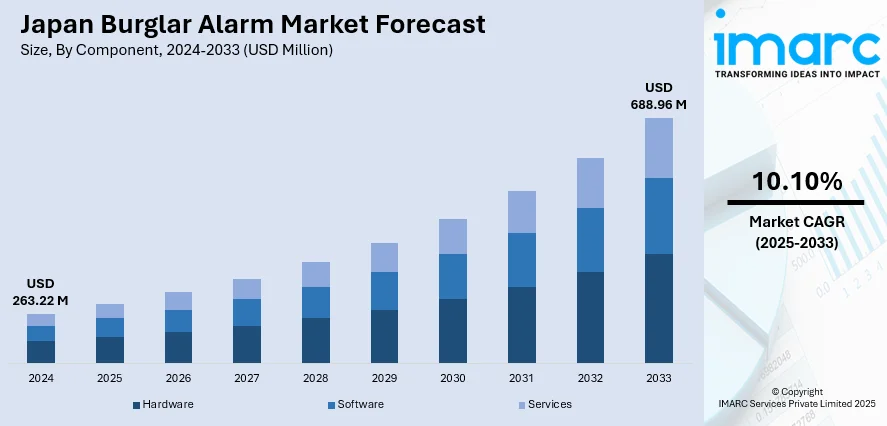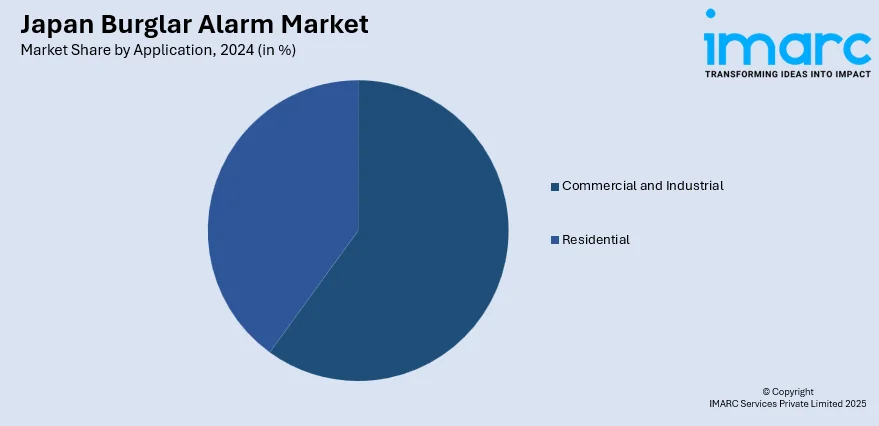
Japan Burglar Alarm Market Size, Share, Trends and Forecast by Component, Application, and Region, 2025-2033
Japan Burglar Alarm Market Overview:
The Japan burglar alarm market size reached USD 263.22 Million in 2024. Looking forward, IMARC Group expects the market to reach USD 688.96 Million by 2033, exhibiting a growth rate (CAGR) of 10.10% during 2025-2033. The market is witnessing significant growth fueled by growing security issues, advancements in technology, and rising popularity of smart home systems. Growing awareness among residential and commercial users about safety measures also escalates the demand for advanced intrusion detection solutions. Key players focusing on innovation and integration with IoT platforms to enhance competitiveness are further contributing to the evolving landscape of the Japan burglar alarm market share.
|
Report Attribute
|
Key Statistics
|
|---|---|
|
Base Year
|
2024 |
|
Forecast Years
|
2025-2033
|
|
Historical Years
|
2019-2024
|
| Market Size in 2024 | USD 263.22 Million |
| Market Forecast in 2033 | USD 688.96 Million |
| Market Growth Rate 2025-2033 | 10.10% |
Japan Burglar Alarm Market Trends:
Perceived Increase in Crime and Security Concerns
While Japan has historically been recognized for its low crime rates, recent trends and public perception indicate a growing concern regarding personal and property security. Media reports on increasing rates in certain categories of crimes, such as in residential burglaries and intrusions, have alerted the homeowners of increased vulnerability. This change in the apparent safety environment is a major booster of the growth of the burglar alarm market. People who once felt safe are now actively looking for steps to defend their homes and families. Increasing desire for improved security and the peace of mind offered by a burglar alarm system are emerging as key considerations for Japanese households, hence directly stimulating demand for these security measures. This proactive approach to safeguarding their properties reflects a changing societal perception of risk.

Technological Advancements and Affordability
The rapid evolution of technology has significantly transformed burglar alarm systems, making them more effective, user-friendly, and accessible to a broader consumer base. Modern systems now boast features like wireless connectivity, seamless smartphone integration for remote monitoring and control, intelligent sensors with sophisticated motion detection algorithms, and even facial recognition capabilities. Furthermore, these advanced alarm systems can often be integrated with other smart home devices, creating a comprehensive security ecosystem. Simultaneously, the cost of these technologies has been decreasing, making home security solutions more affordable for average Japanese households. The combination of enhanced functionality and greater affordability is a key driver propelling the growth of the burglar alarm market, as more consumers find these systems to be a valuable and attainable investment in their safety and security.
Aging Population and Dual-Income Households
Demographic shifts within Japan are also contributing to the increasing demand for burglar alarm systems. The country's aging population includes a growing number of elderly individuals living alone, particularly in more rural areas. These individuals are often more vulnerable and seek the added security and peace of mind that a burglar alarm system can provide, along with potential emergency alert features. Concurrently, the rise in dual-income households means that homes are more frequently unoccupied during the day, increasing the potential risk of burglaries. Burglar alarm systems offer a crucial layer of protection for these unattended properties, providing remote monitoring and immediate alerts in case of any suspicious activity. The specific security needs arising from these demographic trends are a significant factor driving the Japan burglar alarm market growth.
Japan Burglar Alarm Market Segmentation:
IMARC Group provides an analysis of the key trends in each segment of the market, along with forecasts at the country and regional levels for 2025-2033. Our report has categorized the market based on component and application.
Component Insights:
- Hardware
- Central Monitoring Receiver
- Remote Terminal Unit
- Alarm Sensors
- Motion Detection Sensors
- Door/ Window Sensors
- Software
- Services
The report has provided a detailed breakup and analysis of the market based on the component. This includes hardware (central monitoring receiver, remote terminal unit, alarm sensors, motion detection sensors, and door/ window sensors), software, and services.
Application Insights:

- Commercial and Industrial
- Residential
A detailed breakup and analysis of the market based on the application have also been provided in the report. This includes commercial and industrial, and residential.
Regional Insights:
- Kanto Region
- Kansai/Kinki Region
- Central/ Chubu Region
- Kyushu-Okinawa Region
- Tohoku Region
- Chugoku Region
- Hokkaido Region
- Shikoku Region
The report has also provided a comprehensive analysis of all the major regional markets, which include the Kanto Region, Kansai/Kinki Region, Central/ Chubu Region, Kyushu-Okinawa Region, Tohoku Region, Chugoku Region, Hokkaido Region, and Shikoku Region.
Competitive Landscape:
The market research report has also provided a comprehensive analysis of the competitive landscape. Competitive analysis such as market structure, key player positioning, top winning strategies, competitive dashboard, and company evaluation quadrant has been covered in the report. Also, detailed profiles of all major companies have been provided.
Japan Burglar Alarm Market Report Coverage:
| Report Features | Details |
|---|---|
| Base Year of the Analysis | 2024 |
| Historical Period | 2019-2024 |
| Forecast Period | 2025-2033 |
| Units | Million USD |
| Scope of the Report |
Exploration of Historical Trends and Market Outlook, Industry Catalysts and Challenges, Segment-Wise Historical and Future Market Assessment:
|
| Components Covered |
|
| Applications Covered | Commercial and Industrial, Residential |
| Regions Covered | Kanto Region, Kansai/Kinki Region, Central/ Chubu Region, Kyushu-Okinawa Region, Tohoku Region, Chugoku Region, Hokkaido Region, Shikoku Region |
| Customization Scope | 10% Free Customization |
| Post-Sale Analyst Support | 10-12 Weeks |
| Delivery Format | PDF and Excel through Email (We can also provide the editable version of the report in PPT/Word format on special request) |
Key Questions Answered in This Report:
- How has the Japan burglar alarm market performed so far and how will it perform in the coming years?
- What is the breakup of the Japan burglar alarm market on the basis of component?
- What is the breakup of the Japan burglar alarm market on the basis of application?
- What is the breakup of the Japan burglar alarm market on the basis of region?
- What are the various stages in the value chain of the Japan burglar alarm market?
- What are the key driving factors and challenges in the Japan burglar alarm market?
- What is the structure of the Japan burglar alarm market and who are the key players?
- What is the degree of competition in the Japan burglar alarm market?
Key Benefits for Stakeholders:
- IMARC’s industry report offers a comprehensive quantitative analysis of various market segments, historical and current market trends, market forecasts, and dynamics of the Japan burglar alarm market from 2019-2033.
- The research report provides the latest information on the market drivers, challenges, and opportunities in the Japan burglar alarm market.
- Porter's five forces analysis assist stakeholders in assessing the impact of new entrants, competitive rivalry, supplier power, buyer power, and the threat of substitution. It helps stakeholders to analyze the level of competition within the Japan burglar alarm industry and its attractiveness.
- Competitive landscape allows stakeholders to understand their competitive environment and provides an insight into the current positions of key players in the market.
Need more help?
- Speak to our experienced analysts for insights on the current market scenarios.
- Include additional segments and countries to customize the report as per your requirement.
- Gain an unparalleled competitive advantage in your domain by understanding how to utilize the report and positively impacting your operations and revenue.
- For further assistance, please connect with our analysts.
 Request Customization
Request Customization
 Speak to an Analyst
Speak to an Analyst
 Request Brochure
Request Brochure
 Inquire Before Buying
Inquire Before Buying




.webp)




.webp)












